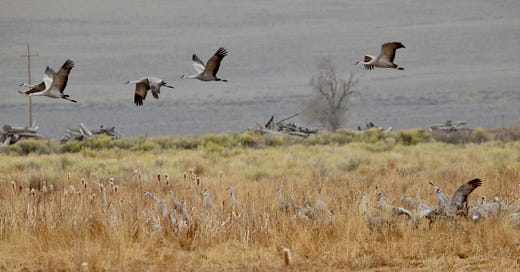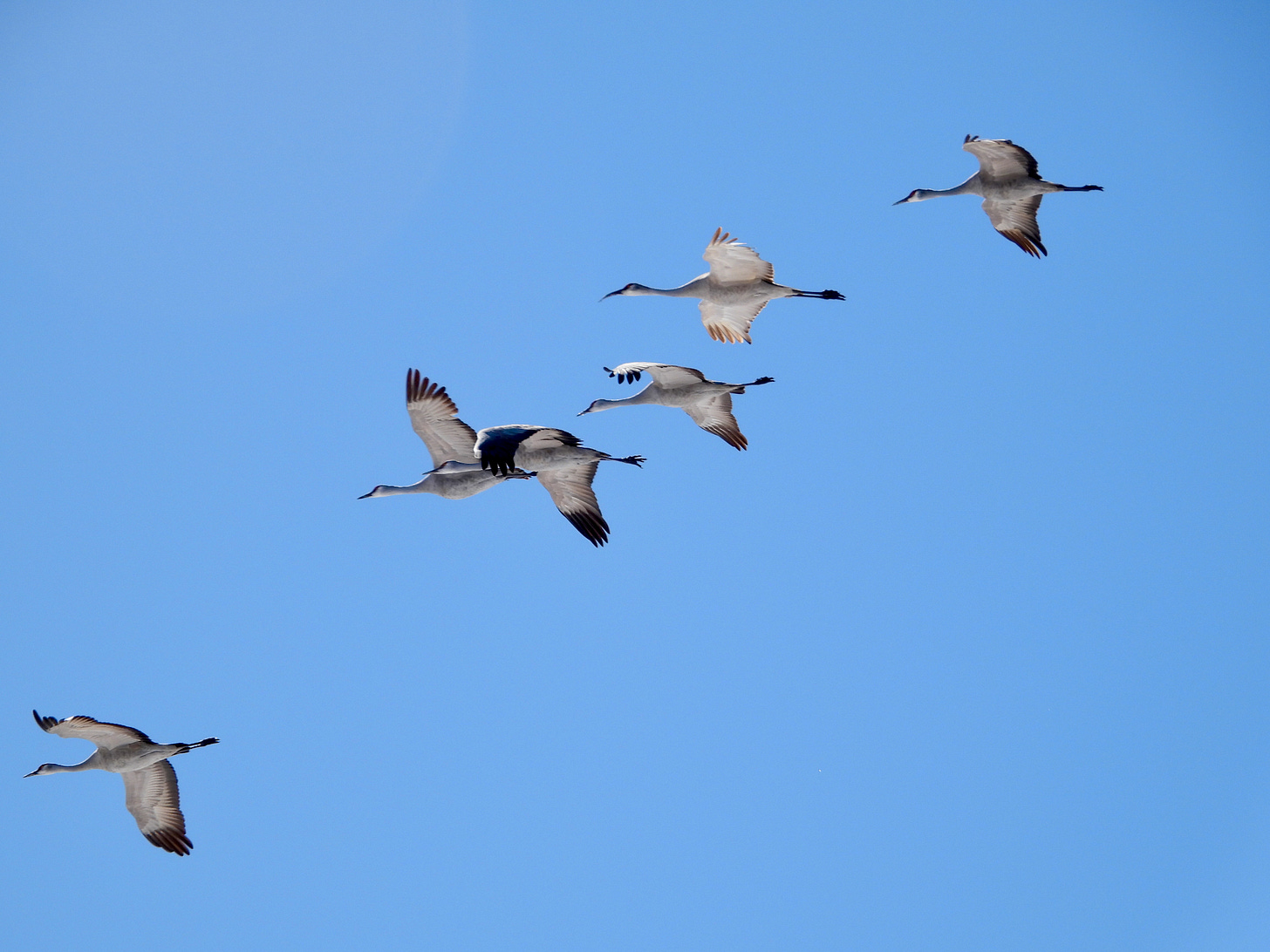
I could still hear cranes in my sleep. Twenty-seven thousand Sandhill crane calls have embedded their distinctive sound deep into my psyche.
My daughter and I spent two days at the various view points at the Monte Vista, Colorado, National Wildlife Refuge watching and hearing thousands of Sandhill Cranes that have returned to their consistent rest stopover on their Spring migration back north. Four-foot tall cranes filled the sky and covered the ground as they moved from roosting (overnight resting/sleeping) sites, to feeding sites in the farm fields, to loafing (leisure and dancing) sites. Often they collected in smaller groups of several dozen moving together, we would watch wave after wave of these crane groups arriving to the feeding site. Other times, nearly the entire flock would rise in a murmuration so clamorous it drowns out all other sounds or even talking to the person next to you. (Sound on for the video! Loudest at the end.)
The cranes’ seasonal return to places like Monte Vista, Colorado, or Kearney, Nebraska has been repeated since long before we humans knew to watch for it and create festivals around it. For hundreds of thousands of years, untold generations of cranes have been returning with their offspring each year to their own nesting sites, teaching the next generation the places to rest on the journey north (or south in the Fall). Their migration takes them from wintering in South Texas, Northern Mexico, and Florida, back up to around the arctic circle in Canada and Alaska for summer breeding. Travel days can cover up to 500 miles, staying aloft at 6,000 to 13,000 feet and higher up. We have seen them many times flying high over the Foothills, and their distinctive honking is heard well before we spot them. Their stop-overs mid-country will last for 30–40 days before they move on once again. By mid-April, the cranes and their honks (distinctive from Canadian Geese honks) will leave Colorado once again.

The Sandhill Crane has become a ‘poster-bird’ for migration in North America. Their size and noise creates enough havoc for us to take notice with fascination. They are the very visible envoys of the broader activity that is happening at the same time. Worldwide, birds, butterflies, and even moths will take to the air soon to return from warmer wintering areas to summer breeding sites long-established in their evolutionary patterns. Similar patterns are happening in the oceans and on land as well, but we’ll stick to the birds for this short essay.
As much as we think to look to seasonal cues such as food resources running low, sun angles, longer or shorter days, and star positions to assume birds know when it’s time to migrate, the whole picture is still less clear. When the combination of these cues comes together, birds begin to exhibit Zugunruhe,[1] a German word for ‘migration anxiety’. They become restless and prepare for their travel days. When it comes time to take off, their compasses guide them to return to birthplaces and resting areas their parents brought them to previously. But how do they find their way?
Humans figured out using the magnetic poles for navigation in the 1400s, this was 2000 years after magnetism was first discovered in 600bc. Humans need tools to tell us about the magnetic poles to make use of their consistent properties to find our way. Many creatures have a ‘magnetoreception’ sense, however, an internal biological compass. From moths to whales, the ‘6th sense’ of magnetoreception is an internal guide they follow.
While we can attribute sight to the cell receptors in our eyes and smell to the design of our nasal passages, the sense of magnetoreception is not one that can be dissected to discover. Magnetic fields pass right through our biological matter, so we have yet to learn what picks up the sense. Several theories are being tested from the mineral magnetite, to electromagnetic induction like sharks have, to quantum physics. Research on this is ongoing and many scientists are eager for answers. Suffice it to say that the birds, and many other creatures, know where to go and how to get there.
Getting there is a wild ride also. Flying at altitudes of 6,000 to over a staggering 30,000 feet (airliner cruising altitude), migrating birds of all sizes get on the move in the spring in flocks so thick they are spotted on radar. Often flying during the night, guided by starlight and by their internal compasses, they can cover thousands of miles. Many types of birds can make the flights non-stop and can even ‘sleep on the wing’, alternately resting a half of their brain at a time, (there’s a lot of ongoing study on this to understand it better). Some make stop-overs like the Sandhill Cranes, others will travel over 90 hours at a time to reach their destination, likely forgoing sleep. Each migration is a marvel of their adaptations to accomplish their instinctive destinations.
Migration is an exhausting endeavor and a vulnerable time for birds. As much as they follow their internal senses to migrate, a lot of external elements come into play as well. Weather patterns, storms, airplanes, city lights, pollution, tall buildings, glass windows, and predators make this an often perilous journey. Some of these things we can do nothing individually to help, but others, we can be a part of conscientious decisions to do our best. Lights are the number one way we can do our part. Birdcast.com will post updates on high migration nights. Here’s Park County, Colorado. You can plug in your own location as well. Cornell Labs, which runs Birdcast.com will send out Migration alerts on their Facebook page. Turning off extra lights will help with bird navigation (and give you a better night sky, chimes in my proofreading astronomy major).

As we move into this Spring, get those binoculars ready to watch your own property for birds you might not see regularly. We had a visit of 75 or so Bohemian Wax Wings last April, and I love spotting a Western Tanager at the feeder. When you see a new bird, you can look it up with the Merlin app and report the sighting also at iNaturalist, which is monitored by many scientists to see where migrating birds are passing through. It’s a bit of citizen science that your participation would be greatly appreciated. Let me know who visits you!
Thank you for stopping by. While my normal life is full with my paying job, other volunteer work, and family time, I write these posts out of my own naturalist curiosity, and love of writing and photography. Many times, this blog has to take a back seat to my other obligations, but I always have the next post on my mind. My subject matter is limitless! If you have enjoyed these posts, I would, shyly, ask for your support of my work here. Please consider subscribing or upgrading to a paid subscription, and do share what you have enjoyed. I am looking at some benes for paid subscribers of artwork from Itsthemoonart, who’s artwork has appeared in other posts and my logo (my naturalist-artist daughter and content advisor) and other ideas. I am very thankful for all my subscribers and supporters! Oh! And please let me know if you have ideas you’d like to see a post about!
Sources:
- https://en.wikipedia.org/wiki/List_of_birds_by_flight_heights
- An Immense World: How Animal Senses Reveal the Hidden Realms Around Us, by Ed Young. Link is public library
- Vesper Flights, by Helen McDonald. Link is public library.
- What It’s Like to be a Bird, by David Sibley. Link is Amazon
- https://naturesdepths.com/magnetic-migration/
- https://www.scientificamerican.com/article/how-migrating-birds-use-quantum-effects-to-navigate/
- https://www.allaboutbirds.org/guide/Sandhill_Crane/overview#
- https://www.fws.gov/sites/default/files/documents/2023%20Crane%20Viewing%20Brochure.pdf
- https://www.alamosa.org/905-faq-the-sandhill-crane-migration-in-the-slv
- https://www.audubon.org/field-guide/bird/sandhill-crane
- https://en.wikipedia.org/wiki/Bird_migration
- https://www.fws.gov/story/migration-its-risky-journey

[1] “When the time comes for birds to migrate, they become visibly restless. Even in captivity, they’ll hop, flit, and flutter. These frantic movements are known as Zugunruhe—a German word that means “migration anxiety.””
— An Immense World: How Animal Senses Reveal the Hidden Realms Around Us by Ed Yong. https://a.co/53QrZ3s
📷 All photos are copyright: Abert Essays unless otherwise noted.
📱 You can find my Abert Essays ‘Encounters’ posts on my social media sites:






